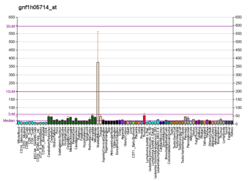| JPH1 |
|---|
|
| Identifiers |
|---|
| Aliases | JPH1, JP-1, JP1, CMT2K, junctophilin 1 |
|---|
| External IDs | OMIM: 605266; MGI: 1891495; HomoloGene: 10761; GeneCards: JPH1; OMA:JPH1 - orthologs |
|---|
| Gene location (Human) |
|---|
 | | Chr. | Chromosome 8 (human)[1] |
|---|
| | Band | 8q21.11 | Start | 74,234,700 bp[1] |
|---|
| End | 74,321,540 bp[1] |
|---|
|
| Gene location (Mouse) |
|---|
 | | Chr. | Chromosome 1 (mouse)[2] |
|---|
| | Band | 1|1 A3 | Start | 17,034,784 bp[2] |
|---|
| End | 17,168,113 bp[2] |
|---|
|
| RNA expression pattern |
|---|
| Bgee | | Human | Mouse (ortholog) |
|---|
| Top expressed in | - quadriceps femoris muscle
- vastus lateralis muscle
- tibialis anterior muscle
- Skeletal muscle tissue of biceps brachii
- deltoid muscle
- Skeletal muscle tissue of rectus abdominis
- gastrocnemius muscle
- muscle of thigh
- body of tongue
- endothelial cell
|
| | Top expressed in | - triceps brachii muscle
- sternocleidomastoid muscle
- temporal muscle
- digastric muscle
- ankle
- muscle of thigh
- intercostal muscle
- soleus muscle
- skeletal muscle tissue
- medial head of gastrocnemius muscle
|
| | More reference expression data |
|
|---|
| BioGPS |  | | More reference expression data |
|
|---|
|
| Gene ontology |
|---|
| Molecular function | - structural constituent of muscle
- molecular function
- calcium-release channel activity
| | Cellular component | - sarcoplasmic reticulum membrane
- endoplasmic reticulum membrane
- plasma membrane
- membrane
- sarcoplasmic reticulum
- junctional sarcoplasmic reticulum membrane
- integral component of membrane
- junctional membrane complex
- endoplasmic reticulum
- Z discdkac
- nucleus
- nucleoplasm
| | Biological process | - regulation of ryanodine-sensitive calcium-release channel activity
- muscle organ development
- calcium ion transport into cytosol
- release of sequestered calcium ion into cytosol
| | Sources:Amigo / QuickGO |
|
| Orthologs |
|---|
| Species | Human | Mouse |
|---|
| Entrez | | |
|---|
| Ensembl | | |
|---|
| UniProt | | |
|---|
| RefSeq (mRNA) | |
|---|
NM_020647
NM_001317830
NM_001363050
NM_001363051 |
| |
|---|
| RefSeq (protein) | |
|---|
NP_001304759
NP_065698
NP_001349979
NP_001349980
NP_065698.1 |
| |
|---|
| Location (UCSC) | Chr 8: 74.23 – 74.32 Mb | Chr 1: 17.03 – 17.17 Mb |
|---|
| PubMed search | [3] | [4] |
|---|
|
| Wikidata |
| View/Edit Human | View/Edit Mouse |
|

















